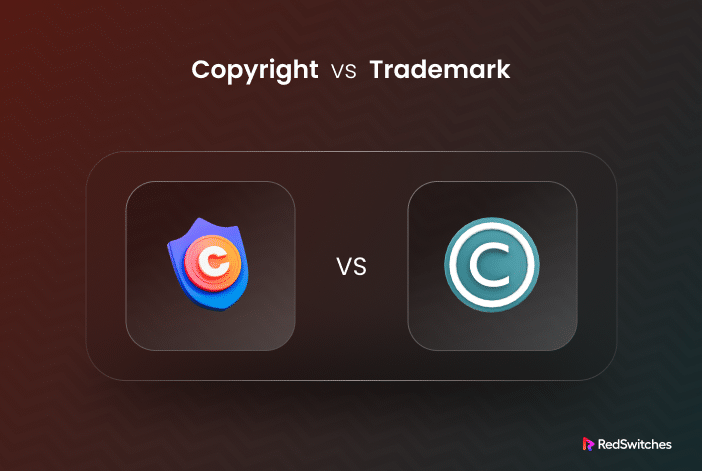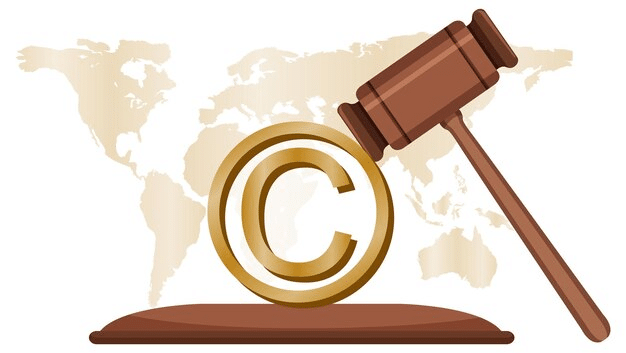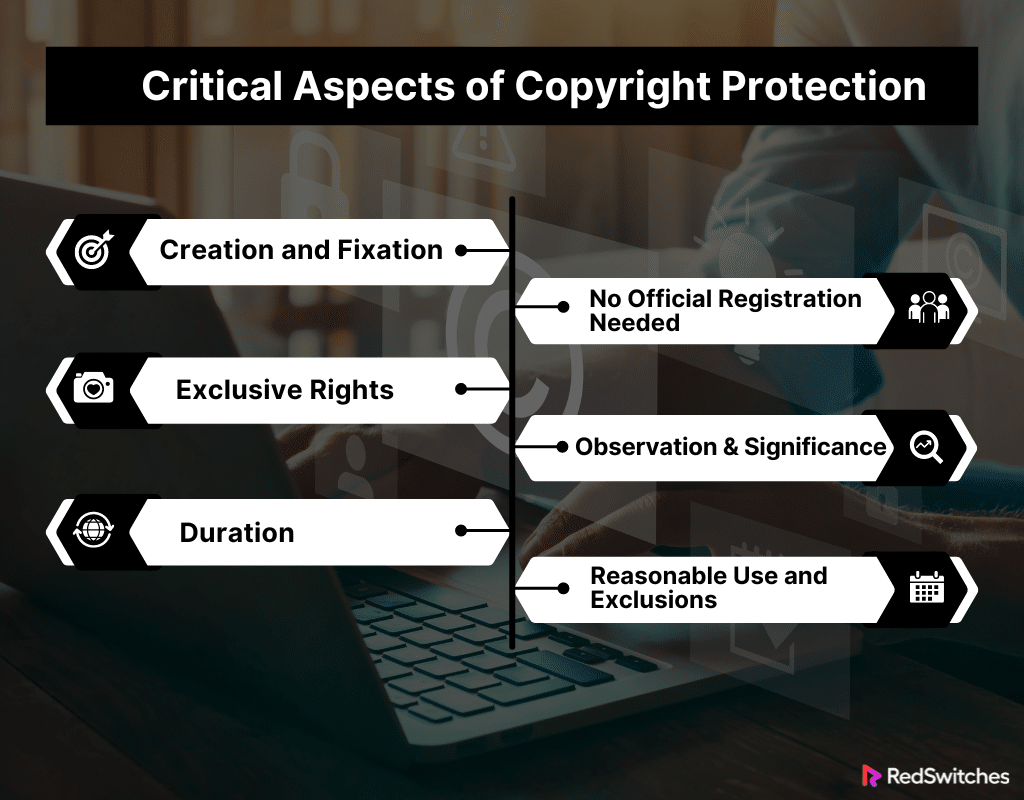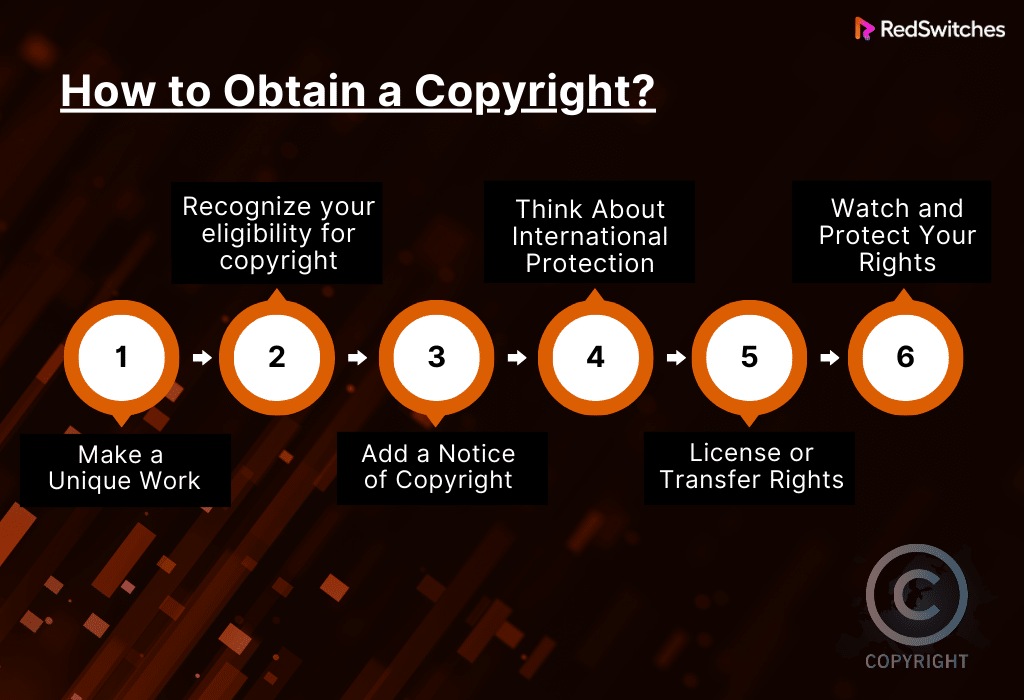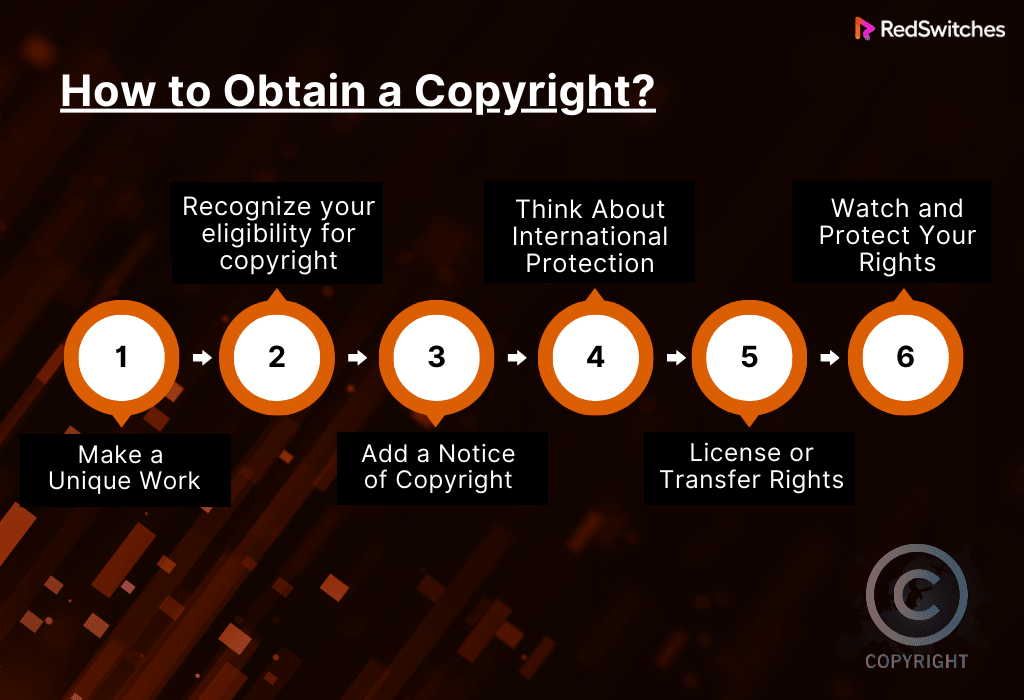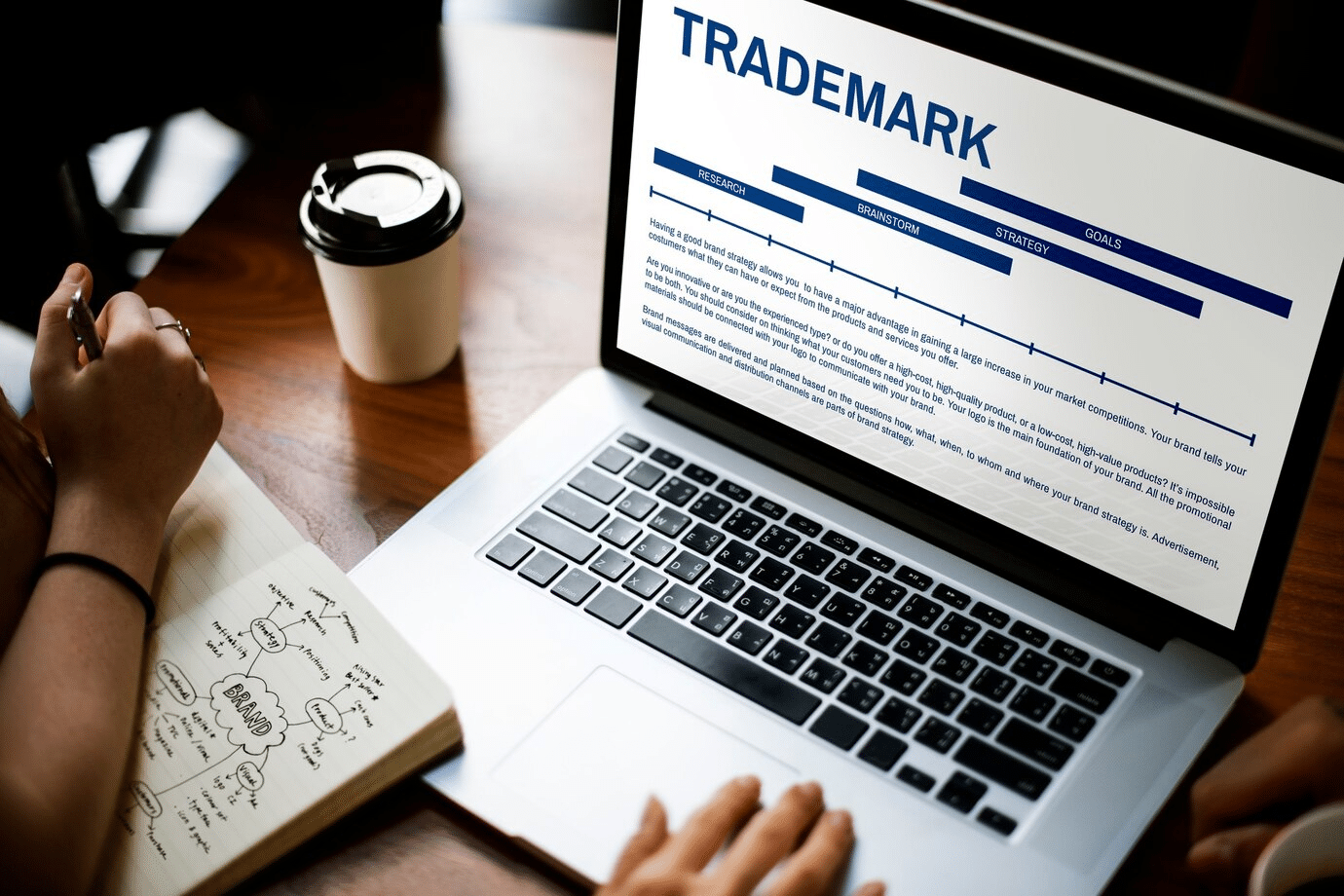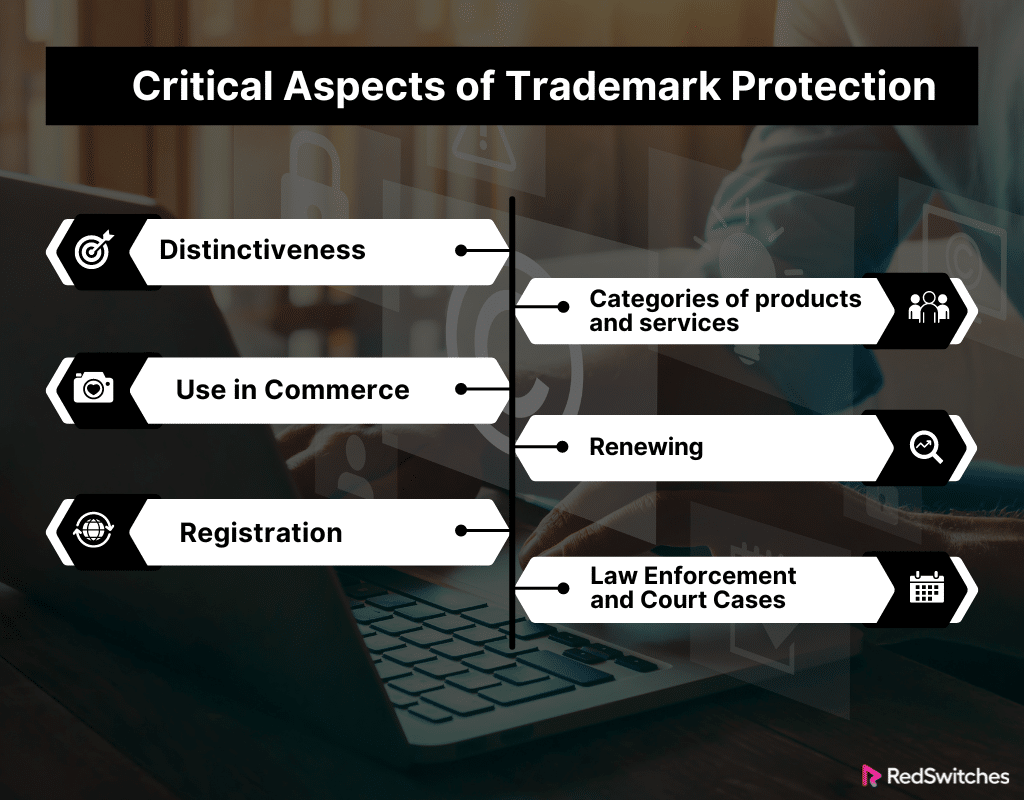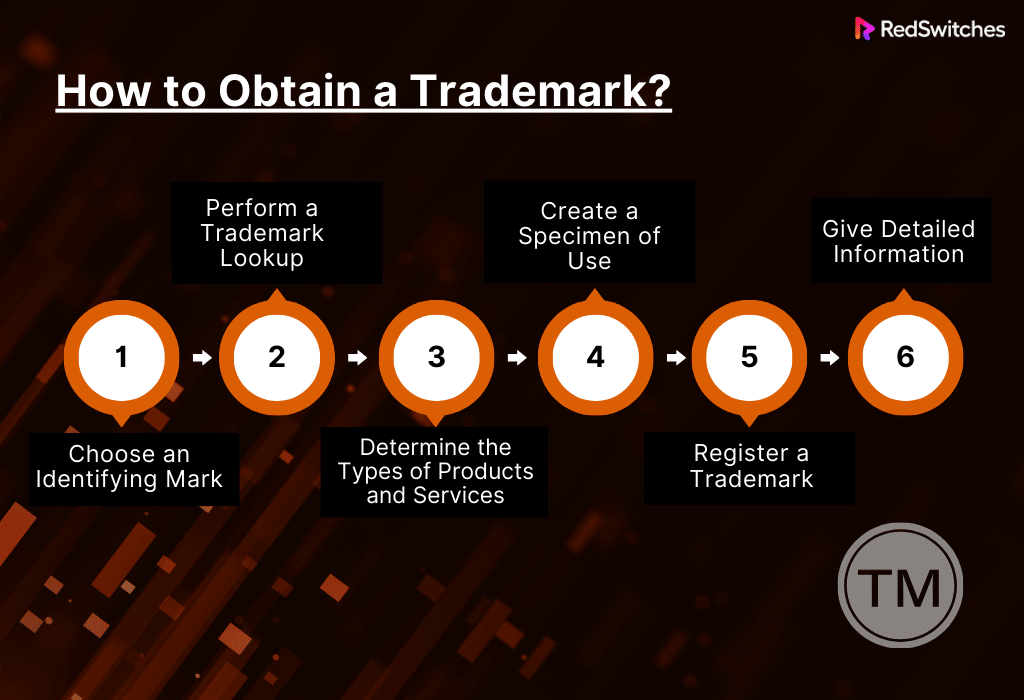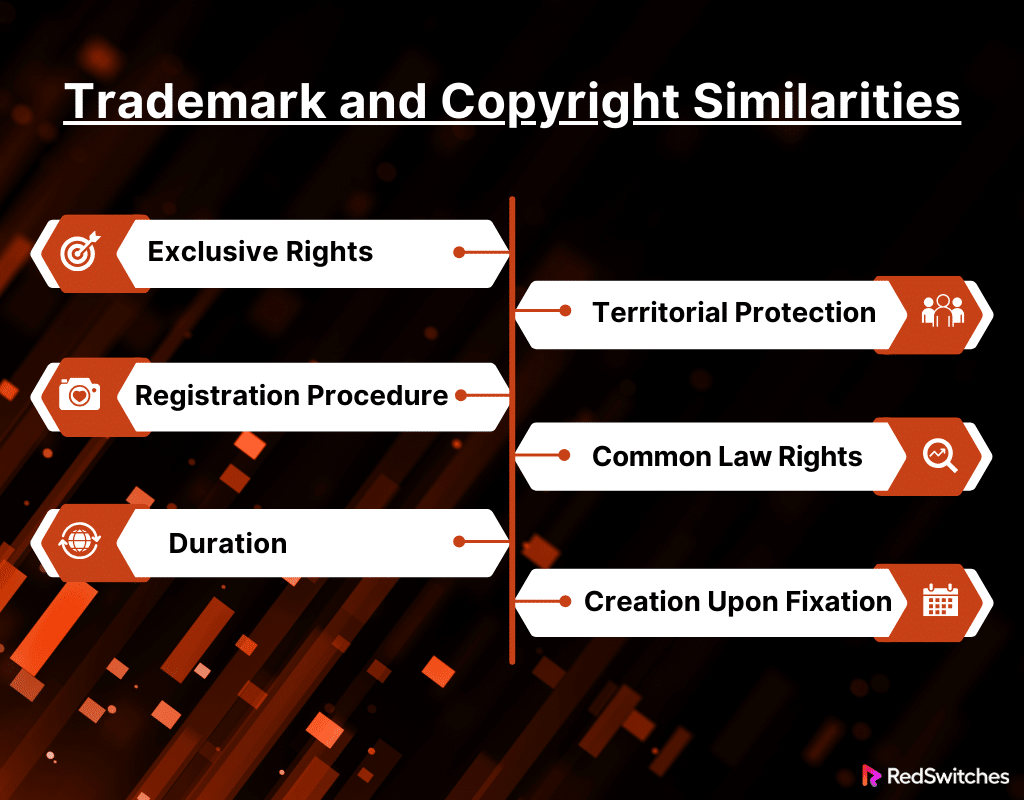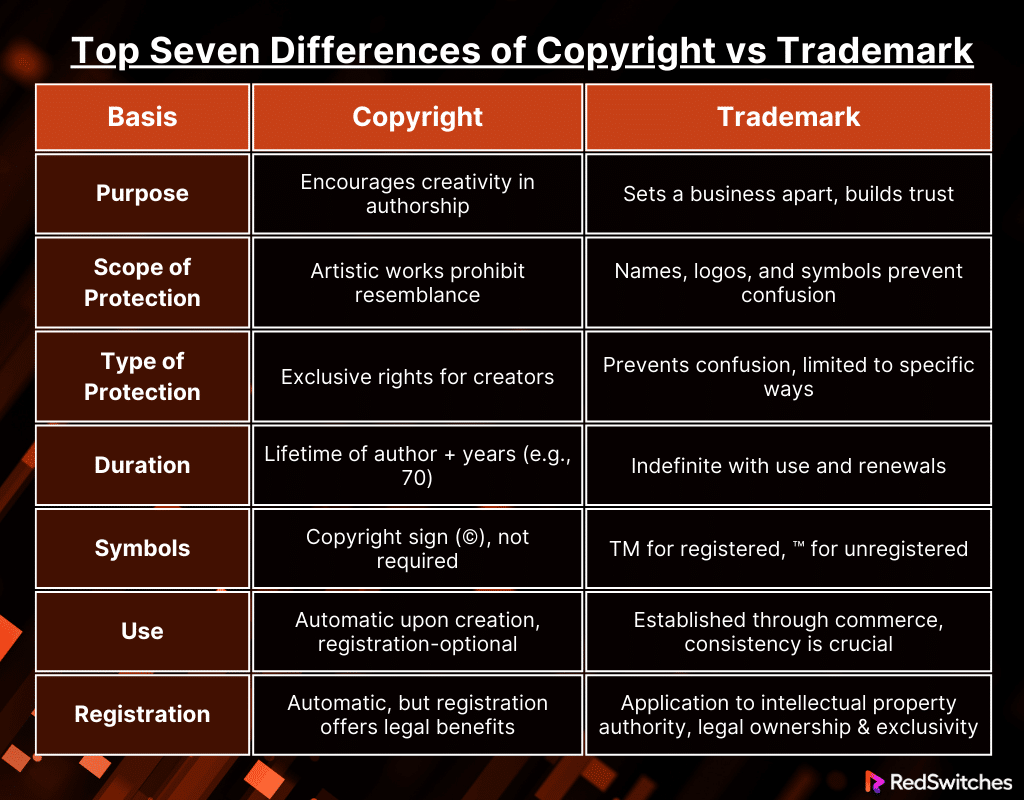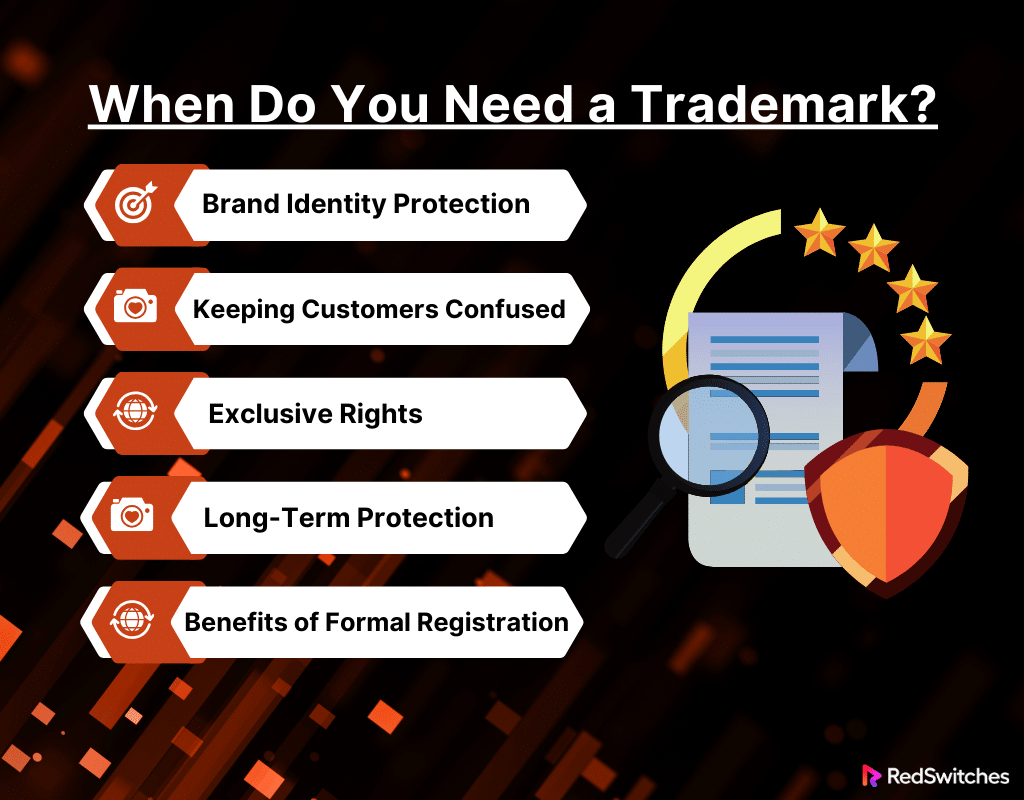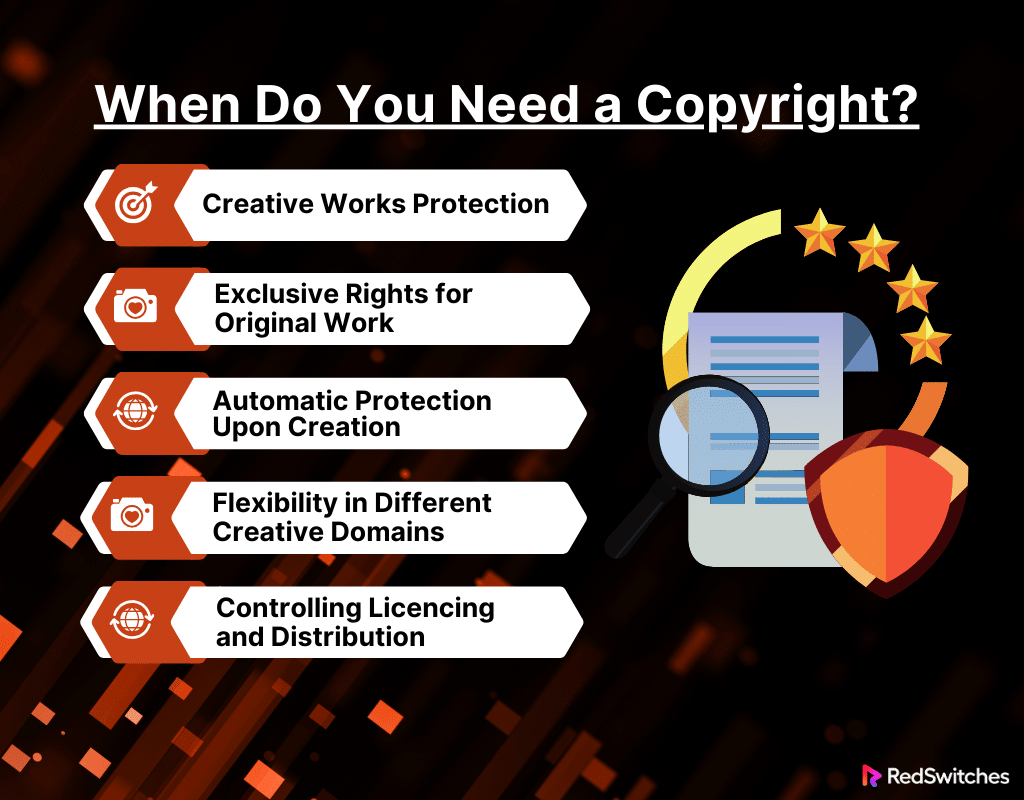Key Takeaways
- Copyrights secure exclusive rights to original artistic and literary works, ensuring creators control reproduction and distribution.
- Trademarks identify and distinguish brands, offering legal protection against confusion or misuse in the marketplace.
- Formal registration of both copyrights and trademarks provides stronger legal standing and broader enforcement capabilities.
- Copyright duration is finite, typically the creator’s life plus a set number of years, whereas trademarks can last indefinitely with proper use and renewal.
- The use of trademarks in commerce establishes rights, while copyright protection is automatic upon the creation and fixation in a tangible medium.
- Understanding and utilizing intellectual property rights effectively safeguards creative content and brand identity, critical for long-term success.
Welcome to our examination of the complex legal frameworks surrounding intellectual property, namely the copyright vs trademark debate. You’ll learn how copyrights safeguard your creative works like books, music, and art, while trademarks protect your brand’s unique symbols and names. We’ll break down these concepts into easy-to-understand terms, helping you determine which type of protection is best for your work. We will also discuss the difference between trademark and copyright.
Come along as we unravel the mysteries and arm yourself with the knowledge you need to protect your works of art or brand in the dynamic realm of intellectual property.
Let’s discuss the long-lasting copyright vs trademark debate in our latest blog.
Table Of Contents
- Key Takeaways
- What is Copyright?
- Definition of Trademark
- Trademark and Copyright Similarities
- Top Seven Differences of Copyright vs Trademark
- Copyright vs Trademark: When Do You Need What?
- Conclusion
- FAQs
What is Copyright?
Credits: Freepik
To compensate the creator for their intellectual investment, copyright is a legal concept granting them exclusive rights to use and distribute their original work, typically for a specified period. This protection is extended to a broad spectrum of artistic, intellectual, or creative forms or “works.”
The following kinds of works are covered by copyright protection:
- Books, essays, and other written works are considered literary works.
- Paintings, sketches, photos, sculptures, and other visual arts are examples of artistic works.
- Musical Works: Lyrics, arrangements, and compositions.
- Dramatic works include screenplays, plays, and scripts.
- Videos, films, and multimedia presentations are examples of audiovisual works.
- Architectural Works: Building blueprints and designs.
What can be Copyrighted?
Credits: Freepik
So, what are the materials/things that can be copyrighted?
Copyright law gives producers of original expressions exclusive rights while protecting various creative works. The primary requirement for eligibility is that the work must be fixed in a physical medium, which implies that it must be kept or recorded in a way that allows it to be viewed or replicated. Below is a more thorough explanation of what is protected by copyright:
Literary Works
- Books: Poetry, novels, nonfiction books, and any other written material.
- Articles: Blog entries, essays, and articles from magazines and newspapers.
- Software for computers: Code and software programs are shielded from legal action as literary works.
Artistic Works
- Visual Arts: Photographs, sculptures, drawings, paintings, and illustrations.
- Infographics, logos, and other visual elements are examples of graphic designs.
- Architecture: Plans, designs, and blueprints related to architecture.
Musical Works
- Original music compositions comprising sheet music.
- Lyrics: Written lyrics are likewise protected.
Dramatic Works
- Plays and Scripts: Screenplays, theatrical plays, and movie scripts.
Audiovisual Works
- Videos and Films: Documentaries, feature films, and other types of video content.
- Television shows: the overall program, the visual components, and the scripts.
Audio Documents
- the real sounds captured, as opposed to the actual musical arrangement.
Photographic Pieces
- images and the artistic decisions that go into composing them.
Works Derived
- translations, adaptations, remixes, and other works based on or modified from previously published copyrighted content.
Transmissions and Live Events
- Both live performances and performance broadcasts are covered by protection.
Dance Pieces
- choreography and dancing moves that are original.
Check out these 13 best WordPress translation plugins for 2024 to see which suits your website.
Copyright Protection
Credits: Freepik
A legal notion known as copyright protection gives authors of original works the sole authority to manage how and where their works are used for a set amount of time. This is a thorough overview of copyright defense:
Critical Aspects of Copyright Protection
Creation and Fixation
When you create something original, copyright protection is automatically granted. For this protection to kick in, your piece of art just needs to be saved or captured in a way that lets others see, copy, or share it—a tangible medium, like a file or a physical form.
Exclusive Rights
The exclusive right to reproduce, distribute, perform, exhibit, and make derivative works based on the original work is granted to the artist under copyright. The copyright owner is the only one who may use these exclusive rights.
Duration
The length of a work’s copyright protection varies depending on the jurisdiction. It typically lasts for the duration of the creator plus an additional number of years (for example, 70 years following the author’s passing). Following this time frame, the work becomes publicly accessible.
No Official Registration Needed
Copyright protection is automatic and doesn’t require registration. However, formal registration is an option and could have additional legal benefits. Registration might help prove ownership in court.
Observation and Significance
It used to be usual practice to inform the public of the rights of the copyright owner on works by adding a copyright notice (e.g., [Year] [Author/Owner]), even though it was not necessary. The globally recognized symbol (©) for copyright is also generally acknowledged.
Reasonable Use and Exclusions
Under the “fair use” concept recognized by copyright law, limited uses of copyrighted content are permitted without permission for teaching, research, news reporting, criticism, and scholarly purposes. Fair use is interpreted differently in each country and might be complicated.
We will compare the scope and type of protection later in our copyright vs trademark distinction section.
Also, read our actionable guide to Linux file permissions to explore exciting things.
How to Obtain a Copyright
In this section, we will discuss how to obtain the Copyright.
#1. Make a Unique Work
An original work is protected by copyright from the moment it is created. This might be anything from creating software to writing poetry, music, or photographs. Work must be concrete, meaning it must be documented or preserved somehow.
#2. Recognize your eligibility for copyright
Make sure the types of works that are eligible for copyright protection—such as artistic, musical, literary, and more—apply to your work.
#3. Add a Notice of Copyright
A copyright notice can alert people to your copyright claim, even if unnecessary. It usually includes the copyright owner’s name, the year of first publication, and the copyright mark (©).
#4. Think About International Protection
If your work’s impact is worldwide, consider obtaining international copyright protection. The Berne Convention provides a basis for international copyright recognition.
#5. License or Transfer Rights
You can provide others licenses so they can use your work under certain restrictions. As an alternative, you can decide to assign some or all of your copyright rights.
#6. Watch and Protect Your Rights
Watch for any possible infringements by routinely monitoring how your work is being used. You have the right to use legal action to enforce your copyright if it is violated.
How Long Does Copyright Last?
Credits: Freepik
The length of a work’s copyright protection varies depending on the jurisdiction. Generally speaking, copyright protection is valid for as long as the creator (author, artist, etc.) is alive, plus an additional number of years. Following this time frame, the work becomes public domain and is usable, replicable, and distributable by everyone without requesting permission.
The following broad rules apply to the length of copyright in the US, the EU, and under the Berne Convention:
United States
Copyright for works created after January 1, 1978, is valid for the author’s lifetime plus an additional 70 years. It lasts for the remaining years of the last living author + 70 years for works with numerous authors.
The copyright period for works created under pseudonyms, works done for hire, and anonymous works is 120 years from the creation date, whichever is shorter.
EU
The length of copyright is the same between EU member states. Copyright for most works lasts for the author’s lifetime plus an additional 70 years.
The copyright life may be shorter for some types of works, such as audiovisual and photographic works.
Berne Convention
An international agreement known as the Berne Convention sets a minimal requirement for copyright protection. It mandates that member nations provide a copyright term at least as long as the author lives, plus fifty years.
Many countries, particularly in the European Union, have extended their copyright durations beyond the Berne Convention’s basic standards.
Definition of Trademark
Credits: Freepik
Any word, phrase, symbol, design, or combination that uniquely distinguishes your products or services can be used as a trademark. It’s how consumers identify you in the market and set you apart from your rivals.
The same term may refer to both service marks and trademarks. A service mark is used for services, and a trademark is used for commodities.
A trademark can:
- Locate the supplier of your products or services.
- Give your trademark legal protection.
- Aid in protecting you against fraud and counterfeiting.
All you need to know about an efficient cloud computing infrastructure is provided in this guide. Be sure to explore it!
What Can Be a Trademark?
Let’s talk about what constitutes a trademark:
Words
Words like brand names, slogans, and catchphrases can be used as trademarks. Among them are “Nike,” “Just Do It,” and “Coca-Cola.”
Symbols and Logos
Common trademarks may include visual symbols and logos. These could be distinctive patterns for a company name, such as the golden arches of McDonald’s or the Apple logo.
Combinations of letters and numbers that are stylized uniquely can be used as trademarks. For instance, “3M” stands for Minnesota Mining and Manufacturing, a global company.
Colors
A particular color or set of colors may be used as a trademark in certain situations. Consider the recognizable brown hue of UPS (United Parcel Service) vehicles.
Sound Sequences
Trademarks like jingles or musical notes can be filed for distinctive sound sequences. The Intel chime and the roar of the MGM lion are two examples.
Shapes and Trade Dress
A product’s unique form, or its packaging, can serve as a trademark. Trade dress is the term for this. A well-known example is the distinctive shape of the Coca-Cola bottle.
Scents & Perfumes
Rarely, distinctive smells or perfumes connected to a product may be filed for trademark registration. For instance, the floral aroma of a specific brand of sewing thread.
Taste and Texture (in Certain Situations)
Although more challenging to defend, some unique flavors or textures connected to a product could be eligible for trademark protection.
Trademark Protection
The legal mechanism of trademark protection grants exclusive rights to the proprietors of unique markings, symbols, or words to identify and set their goods or services apart from their competitors. Essential aspects of trademark protection consist of the following:
Distinctiveness
Trademarks must be distinctive and capable of identifying the source of goods or services. Distinctiveness can be inherent or acquired through use.
Use in Commerce
Trademark rights are often established through using the mark in commerce. Use in commerce can include the sale of goods or the offering of services under the mark.
Registration
While registration is not required, it provides several benefits, including nationwide (or jurisdiction-specific) exclusivity, a legal presumption of ownership, and the ability to sue for statutory damages in case of infringement.
Categories of Products and Services
Specific categories of products and services are covered by trademark registration. Candidates need to specify which classes apply to their goods and services.
Renewing
The term of trademark registration is typically 10 years, although it can be extended forever, provided the mark is being used, and the renewal costs are paid.
Law Enforcement and Court Cases
Owners of trademarks can use the legal system to uphold their exclusive rights. This could entail legal action to halt infringement, requesting compensation, or securing an injunction.
How to Obtain a Trademark
So, let’s discuss how to obtain a trademark.
Choose an Identifying Mark
Select a logo that is easily recognizable and can be used to pinpoint the origin of your products or services. It is more likely that distinctive marks will be registrable.
Perform a Trademark Lookup
Do a thorough trademark search to ensure your preferred brand isn’t being used or registered by someone else. By doing this, possible disputes and rejections during the registration procedure are avoided.
Determine the Types of Products and Services
Ascertain which categories of products and services are related to your brand. You must determine which trademark registration classes apply to your goods or services because trademarks are registered for specified classes.
Create a Specimen of Use
To apply for a trademark based on commerce, you might have to provide a specimen of use, proof that the trademark is being used for the listed products or services.
Register a Trademark
Register a trademark with the appropriate intellectual property office. For the United States, this is frequently the United States Patent and Trademark Office (USPTO), while for the European Union, it is the European Union Intellectual Property Office (EUIPO).
Give Detailed Information
The application should contain comprehensive details regarding the mark, the products or services it denotes, and its owner. Moreover, it should also provide a precise and comprehensive submission.
How Long Does a Trademark Last?
Some variables, such as the jurisdiction, the trademark’s continuous use, and its renewal, affect how long it is protected. The following are some broad guidelines:
Duration at Start
First, a trademark that is successfully registered, is usually protected for ten years from the date of registration.
Renewing
After the first 10-year period, you must periodically renew the registration to keep trademark protection. Jurisdiction-specific deadlines and requirements for renewals differ.
Constant Utilization
For a trademark to be deemed legitimate, it must be actively and consistently utilized in commerce. A trademark may be canceled if not used for a long time.
Use-it or Lose-it Principle
The “use-it-or-lose-it” rule states that a trademark owner must actively utilize the mark to maintain exclusive rights. It is adhered to by many jurisdictions. The mark’s protection may be lost if not used for a predetermined time.
Periods of Renewal
Owners of trademarks can usually extend their registration for one or more terms, usually lasting ten years. The opportunity to renew may remain as long as the mark is being used and the renewal payments are being paid.
Trademark and Copyright Similarities
After discussing everything about trademarks and copyrights, we will discuss the similarities of both in our copyright vs trademark debate.
Intellectual Property Protection
Copyrights and trademarks are two types of intellectual property (IP) protection. IP protection is a more general term that includes the legal rights of intangible works of art.
Exclusive Rights
The owner has the exclusive authority to use and manage their assets protected by trademarks and copyrights. These rights forbid unauthorized use, duplication, or exploitation of protected content.
Registration Procedure
Trademarks and copyrights can profit from formal registration with the appropriate intellectual property authority, even if registration is not necessary to form rights. In addition to improving the owner’s ability to assert their rights, registration offers additional legal advantages.
Duration
The periods for copyrights and trademarks are both finite. As long as the mark is used and the renewal payments are paid, trademark protection can be extended forever. In general, copyright protection is valid for the creator’s lifetime plus a predetermined amount of years.
Territorial Protection
As rights are recognized only inside the jurisdiction in which they are conferred, both forms of protection are often territorial. On the other hand, international accords, like the Berne Convention, make recognition and protection possible beyond national boundaries.
Common Law Rights
Common law rights, which result from using or creating intellectual property without official registration, can establish trademarks and copyrights.
Creation Upon Fixation
Copyright protection is automatically granted when an original work is created and fixed in a physical medium. Similarly, using a distinctive mark in commerce can birth common law trademark rights.
Top Seven Differences of Copyright vs Trademark
In this section of our blog article, we will discuss the core part of our blog i.e. copyright vs trademark debate, with the help of critical differences between them.
Credits: Freepik
Copyright vs Trademark: Purpose
The first parameter of difference in our copyright vs trademark debate is the purpose of both. Let’s discuss.
Copyright
The main goals of copyright and trademarks are distinct. Original works of authorship, such as literary, artistic, and musical works, are safeguarded by copyright laws. It gives the author the authority to copy, share, and perform their creations. By giving authors control over how their intellectual works are used, copyright is intended to encourage creativity.
Trademark
Trademarks are used to protect names, logos, and slogans that are connected to a brand. They are mainly used to set a business apart from its rivals’ goods and services, fostering customer trust and preventing confusion in the marketplace. Trademarks are necessary for businesses to successfully market themselves and have a unique personality.
Check out these 7+ cloud computing advantages and disadvantages.
Copyright vs Trademark: Scope of Protection
The next aspect of copyright vs trademark is the scope of protection.
Copyright
Though ideas themselves are not protected by copyright, their expression is. It encompasses various artistic mediums, such as music, software, painting, and literature. Copyright prohibits direct duplication and significant resemblance to the protected work.
Trademark
Words, symbols, and other identifiers that set apart the source of products or services are protected by trademark law. The goal of the protection is to avoid consumer confusion and is more limited than copyright. Names, logos, and product packaging or design can be trademarks.
Copyright vs Trademark: Type of Protection
What is the type of protection? Let’s discuss this concerning copyright vs trademark.
Copyright
An original work’s creator is granted several exclusive rights under copyright. These rights cover the ability to distribute copies, perform, make derivative works, reproduce the work, and publicly show it.
Trademarks
Trademarks offer distinct protection, primarily stopping others from using marks that confuse consumers in specific ways. As long as there is no chance of confusion, trademark protection does not stop third parties from independently developing comparable goods or services.
Copyright vs Trademark: Duration
How do we compare the duration in our copyright vs trademark argument? Let’s discuss.
Copyright
Different copyright protection periods apply depending on the jurisdiction and kind of work. Generally speaking, copyright is valid for the author’s lifetime plus an additional number of years (for example, 70 years after the author’s passing). Following this time frame, the work becomes publicly accessible.
Trademark
As long as the mark is used and renewal payments are paid, trademark protection may be extended indefinitely. Trademarks can be protected for as long as they are actively utilized and maintained, unlike copyright, which has a finite lifespan.
Copyright vs Trademark: Symbols
The next difference in the trademark versus copyright debate is the symbol differences.
Copyright
To show that a work is protected by copyright, the copyright sign (©) is frequently employed. For copyright protection, official usage of the symbol is not necessary.
Trademark
Symbols like TM for registered trademarks and ™ for unregistered trademarks are frequently used to identify trademarks. Only trademarks that have completed the formal registration process with the relevant intellectual property agency can use the registered trademark sign.
Copyright vs Trademark: Usage
Let’s see the usage of copyright vs trademark below:
Copyright
When an original work is created, copyright laws automatically protect it. Copyright can exist even in the absence of a formal registration. On the other hand, copyright registration with the appropriate authorities can offer extra-legal advantages.
Trademark
Use in commerce establishes trademark rights. Although it is not required, registration can improve legal protection and establish ownership. To preserve and uphold trademark rights, trademarks must be used consistently and legitimately.
Copyright vs Trademark: Registration
How does registration differ? Let us understand this in our copyright vs trademark debate.
Copyright
Copyright protection does not necessitate formal registration. When an original work is created and fixed, copyright is automatically granted. Nonetheless, registering with the appropriate copyright agency may have further legal benefits, particularly regarding enforcement.
Trademark
To register a trademark, apply to the appropriate intellectual property authority, such as the European Union Intellectual Property Authority (EUIPO) or the United States Patent and Trademark Office (USPTO). A legal assumption of ownership and national (or jurisdiction-specific) exclusivity are two advantages of registration.
While discussing the diff between copyright and trademark. Let’s summarize it in a tabular format.
Copyright vs Trademark: When Do You Need What?
In this section of our copyright vs trademark debate, we will discuss when to choose a Copyright and when you need a Trademark.
When do you need a Trademark?
Brand Identity Protection
Trademark protection is crucial if your top goal is safeguarding the distinctive identifiers connected to your goods or services, such as names, logos, slogans, or symbols. By protecting your brand’s identity, trademarks ensure that customers can quickly recognize and distinguish your products from your competitors.
Keeping Customers Confused
Select a trademark when there is a severe chance that customers will become confused. Trademarks shield other parties from using identical marks in ways that could mislead customers or give the false impression that your company is associated with them. This is essential to preserving customer confidence and safeguarding your company’s reputation.
Trademarks Confer Exclusive Rights
Using the mark with specific goods or services and in your marketing helps you position them uniquely. Choosing a trademark enhances your ability to make your goods and services stand out as distinct and trustworthy. It helps establish and maintain your brand’s uniqueness in the marketplace.
Long-Term Protection
As long as a trademark is regularly used and renewal costs are paid, it can be renewed indefinitely. Businesses building enduring brand recognition and loyalty will find this long-term protection valuable.
Benefits of Formal Registration
Choose a trademark when pursuing benefits from formal registration. These benefits include the right to use the registered trademark sign (®), countrywide (or jurisdiction-specific) exclusivity, and a legal presumption of ownership. A formal registration gives your brand a solid legal base and improves your ability to assert your rights.
Also, read this comprehensive guide on how to start an eCommerce business.
When do you need a Copyright?
After discussing the copyright vs trademark key differences, let’s discuss when you need a copyright.
Creative Works Protection
Copyright is the best option if you have produced original works of authorship, such as software, music, art, or literature, and your main goal is to safeguard how your ideas are expressed. Your creative works’ actual form and content are protected by copyright.
Exclusive Rights for Original Works
If you want the only authority to copy, distribute, perform, and exhibit your original works, go for copyright. Your creative content is protected by copyright, preventing unauthorized use or duplication.
Automatic Protection Upon Creation
If you would rather have a system that offers automatic protection as soon as your work is created and fixed, go with copyright. Copyright protection does not necessitate official registration, in contrast to trademarks.
Flexibility in Different Creative Domains
Because of its adaptability and applicability to many creative industries, copyright is appropriate for writers, singers, artists, filmmakers, and software engineers. It protects the essence of your creative production by including various expression methods.
Controlling Licencing and Distribution
Revenue-Generating Techniques Copyright provides the legal framework to regulate how others use your content if you intend to license or distribute your creative works. This is especially crucial for artists and content creators hoping to profit from their works via several platforms. Here’s how revenue generation is facilitated by copyright:
Opportunities for Licencing: Under some conditions, copyright permits authors to grant licenses to others so that they may use, reproduce, or distribute their works. This becomes more important when artists collaborate, as they may use their copyrighted content to create partnerships that benefit both parties, reach a wider audience, and earn money through licensing deals.
Distribution Channels: Content creators frequently try to disseminate their work over various channels to increase visibility and revenue sources. The required security to manage the where, when, and how of their content distribution is provided by copyright.
Artists can control how their works are distributed to maximize profits using internet platforms, conventional media, or newly developed technologies.
Conclusion
In summary, understanding intellectual property protection requires a clear grasp of the distinctions between trademarks and copyrights. We examined the essential features that distinguish these two foundations of intellectual property protection. Every component, from duration and registration to purpose and scope, is vital in determining how intellectual property rights are shaped. We tried to solve the copyright vs trademark debate for once and all.
Understanding the value of copyright protection for creative works and trademark protection for brand identification, it is clear that decisions in this area significantly impact innovators, enterprises, and creators alike. Securing creative expressions and unique brand characteristics in the complicated interaction between creativity and commerce becomes strategically necessary.
Trademarks protect online identities as we at RedSwitches traverse the complex pathways of digital presence. In the same way, copyright protects artistic endeavors, trademarks strengthen the digital footprint by guaranteeing a distinct and identifiable presence in the broad internet space.
FAQs
Q. Copyright vs Trademark: What is the difference between trademark and copyright?
While trademarks protect brand identifiers like names, logos, and slogans, copyright protects original works of authorship. Trademarks and copyrights serve both types of intellectual property protection.
Q. Copyright vs trademark: What is an example of each?
The distinctive Nike swoosh symbol represents a trademark, while an original composition is protected by copyright.
Q. Copyright vs Trademark: Which is more powerful?
The strength of a trademark or copyright depends on the type of intellectual property and its intended protection. Copyrights safeguard artistic expression, while trademarks excel at preserving brand identity.
Q. Is IP copyrighted?
Although the term ‘intellectual property’ is broad and includes patents, trademarks, and copyrights, IP is not protected by copyright. Every group has a different kind of protection.
Q. What is the difference between copyright and trademark?
Copyright protects original works of authorship, while trademarks protect symbols, names, and slogans used to identify the source of goods or services.
Q. How do I know if I should copyright or trademark my work?
Copyright is automatically granted once a work is created and fixed in a tangible form, while trademarks need to be registered with the appropriate authority to receive legal protection.
Q. Can I trademark a business name?
You can register a business name as a trademark to protect the brand identity associated with your products or services.
Q. What is the process for registering a trademark?
To register a trademark, you need to submit an application to the appropriate government office, such as the U.S. Patent and Trademark Office, and meet certain criteria for trademark eligibility.
Q. How can I differentiate between a copyright symbol and a trademark symbol?
The copyright symbol (©) is used to indicate ownership rights over original works, while the trademark symbol (™) is used to show that a name, logo, or slogan is being used as a trademark.
Q. When should I use a copyright notice?
Using a copyright notice on your work is recommended to inform others that your work is protected by copyright and to deter potential copyright infringement.
Q. How do I protect my intellectual property through copyright and trademark laws?
By understanding the differences between copyright and trademark and registering your intellectual property, you can safeguard your original works and brand identity from infringement.
